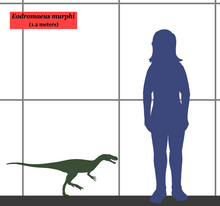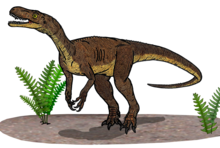Eodromaeus
| Eodromaeus Temporal range: Late Triassic,
| |
|---|---|

| |
| Size comparison between Eodromaeus and a human. | |
| Scientific classification | |
| Missing taxonomy template (fix): | Eodromaeus murphi |
Eodromaeus (meaning "dawn runner") is an extinct genus of basal theropod dinosaur known from the Late Triassic period of Argentina.[1] It has been cited by Sereno as resembling a supposed common ancestor to all dinosaurs, the "Eve" of the dinosaurs.[2]
Discovery
Fossils from Eodromaeus was first discovered in 1996 by argentinean paleontologist Ricardo N. Martinez and Earthwatch volunteer Jim Murphy, and it was first believed that it was a new species of Eoraptor. However, as the researchers started to take a closer look at the fossils, they found that it had many skeletal features which were absent in Eoraptor,[3] and they understood that it came from a new genus.
Eodromaeus is known from the holotype PVSJ 560, a nearly complete articulated skeleton recovered from the Valle de la Luna Member of the top of the Ischigualasto Formation, and the referred materials PVSJ 534, PVSJ 561, PVSJ 562 and PVSJ 877 from Valle de la Luna, La Peña and Cancha de Bochas Members of Ischigualasto, dating to the early Carnian faunal stage of the early Late Triassic, about 232–229 million years ago.[1]
Description

Eodromaeus was a relatively small dinosaur, with a total length of about 1.2 metres (3.9 ft) from nose to tail, and a weight of about 5 kilograms (11 lb). The trunk was long and slender. It is unknown how fast Eodromaeus could run, but it has been suggested to about 30 kilometres per hour (19 mph).[4] It is a basal carnivorous theropod. The forelimbs were much shorter than the hindlimbs, ending in hands with 5 digits. Digits IV and V (the ring finger and little finger in humans) were very reduced in size.[1]
Etymology
Eodromaeus was named by Ricardo N. Martínez, Paul C. Sereno, Oscar A. Alcober, Carina E. Colombi, Paul R. Renne, Isabel P. Montañez and Brian S. Currie in 2011 and the type species is Eodromaeus murphi. The generic name is derived from the Greek words Eos ("Dawn", "Early") and Dromaeus ("Runner"). The specific name honors Jim Murphy, who used to work the area nearby where the fossils were found.[1]
Phylogeny
Eodromaeus is regarded as an early member of theropoda, the group which includes the carnivorous dinosaurs. With the discovery of Eodromaeus, Eoraptor (which also has been regarded as a theropod) has been classified as a member of the sauropodomorpha, the group which includes animals like Apatosaurus.[1] This has been questioned by Bergman and Sues, who have reclaimed Eoraptor as a theropod, like Eodromaeus.[5]
Cladogram after Martinez et al., 2011:[1]
References
- ^ a b c d e f Ricardo N. Martinez, Paul C. Sereno, Oscar A. Alcober, Carina E. Colombi, Paul R. Renne, Isabel P. Montañez and Brian S. Currie (2011). "A Basal Dinosaur from the Dawn of the Dinosaur Era in Southwestern Pangaea". Science. 331 (6014): 206–210. doi:10.1126/science.1198467. PMID 21233386.
{{cite journal}}: CS1 maint: multiple names: authors list (link) - ^ Bowdler N, "'Dawn runner casts light on birth of the dinosaurs", www.bbc.co.uk, 13-1-2011.
- ^ Choi T.Q., "Dinosaur Graveyard Reveals Oldest T. Rex Relative: Dawn Runner", www.FoxNews.com, 13-01-2011.
- ^ Weise E, "New dog-sized dinosaur discovered", www.usatoday.com, 23-01-2011.
- ^ Bergman D.S., Sues H-D. (2011), "A late-surviving basal theropod dinosaur from the latest Triassic of North America", Proceedings of the Royal Society B, publisched online 13-4-2011.
